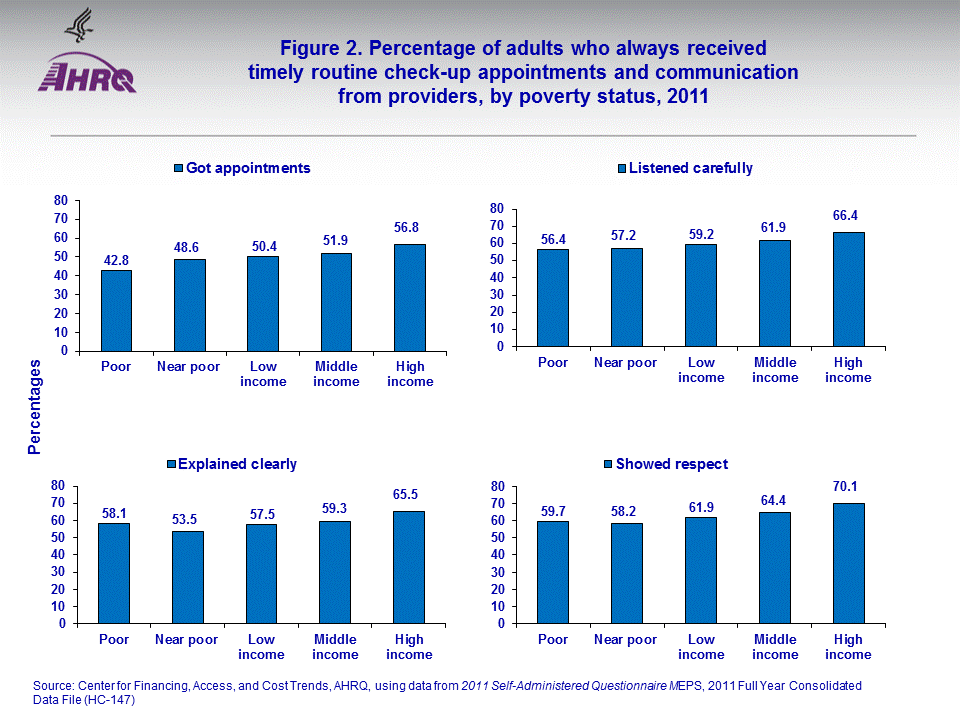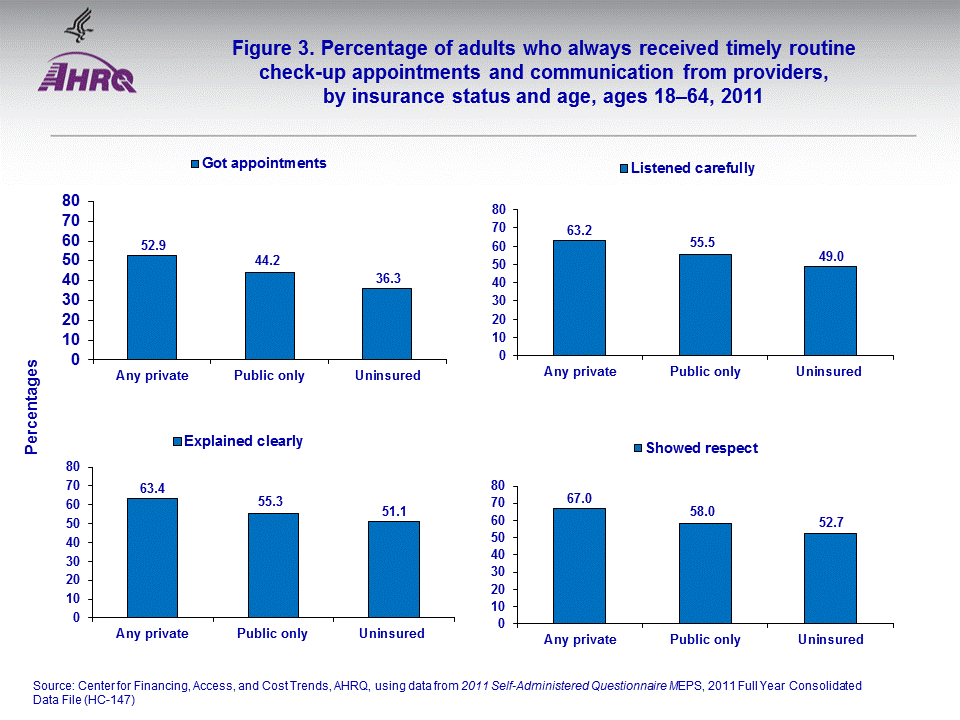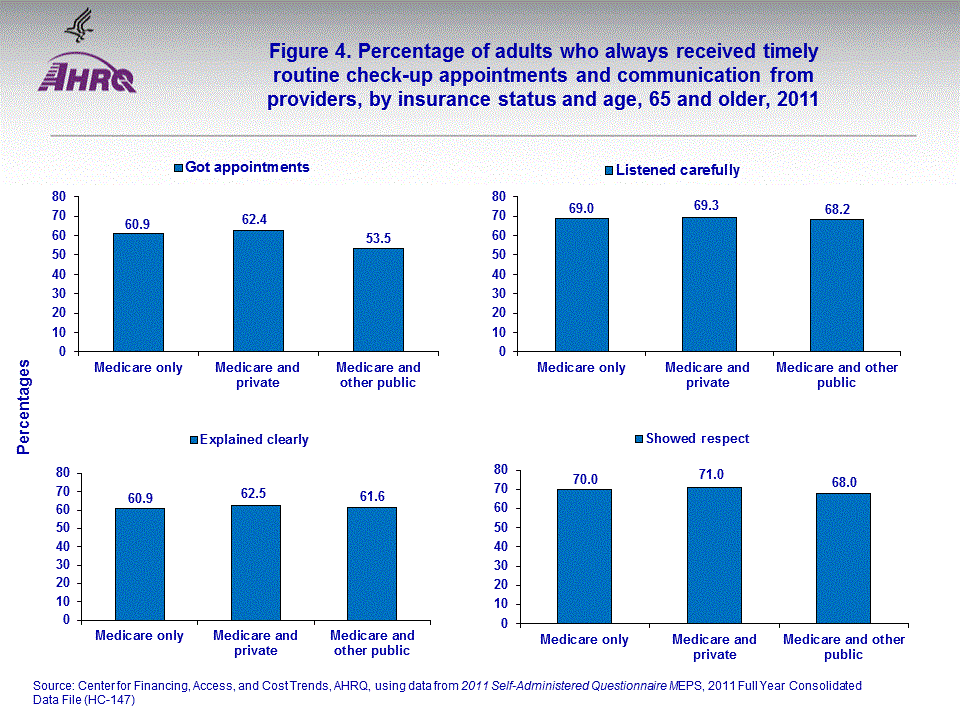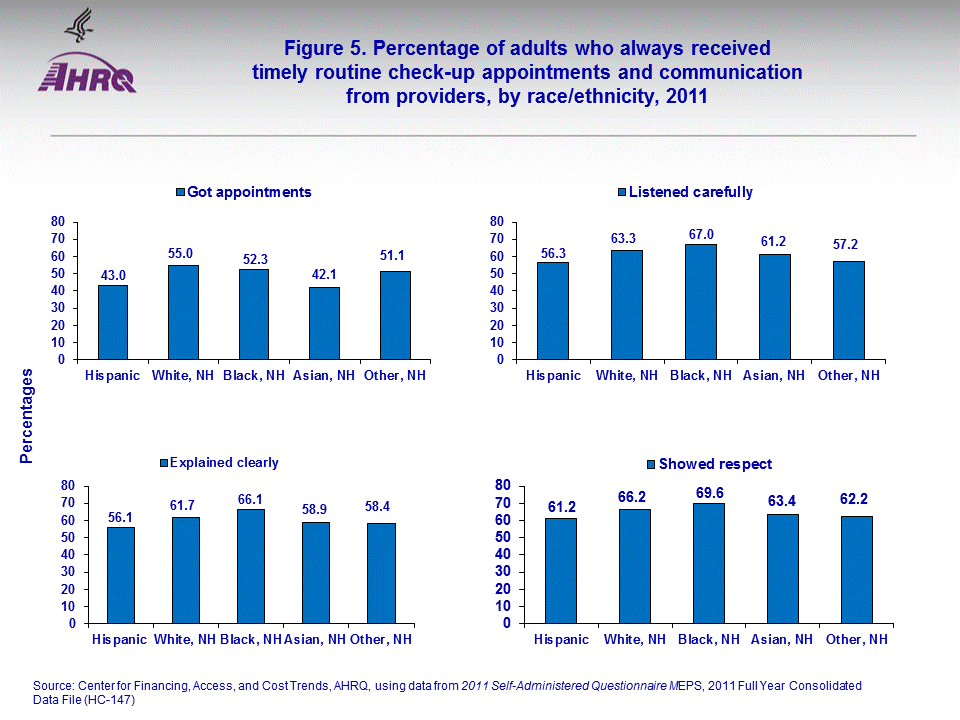
|
|
Font Size:
|
||||
|
|
|
|
||||
STATISTICAL BRIEF #462:
Experiences with Health Care Providers during Routine Care, Adult U.S. Civilian Noninstitutionalized Population, 2011
Highlights
- About half of adults (age 18 and older) received routine care appointments as soon as they thought they needed them.
- Adults with high incomes received appointments as soon as they thought they needed them at higher rates than all other income groups.
- Adults ages 18-64 with private insurance always received routine care appointments as soon as they thought they were needed at a higher rate than adults ages 18-64 with no insurance.
- Two-thirds of adults with high income reported that the doctors always listened carefully to them.
- Less than half of uninsured adults ages 18-64 reported that their doctors always listened carefully to them.
- Non-Hispanic black adults were more likely to report that their health care providers always listened carefully to them, compared with all other race/ethnicity groups.
Introduction
The most common reason for visiting a health care provider is for routine care. Routine care is typically defined as a visit with a doctor or other health professional for assessing overall health, usually not prompted by a specific illness or complaint. Routine care appointments for this analysis have been defined as any appointment with a health care professional for care that was not needed right away.This Statistical Brief analyzes data from the MEPS-HC Self-Administered Questionnaire to estimate whether adults were able to get routine care appointments as soon as they thought they were needed, as well as the extent to which health care providers listened to patients and offered clear explanations to them. The estimates compare experiences by age, insurance, and poverty status. All comparisons discussed in the text are statistically significant at the .05 level unless otherwise noted.
Findings
About half of adults (52.7 percent) in the United States received routine care appointments as soon as they thought they needed them (figure 1). Those over age 65 received these timely appointments at higher rates than those between the ages of 18 and 64 (60.8 percent versus 50.3 percent, respectively). Seven out of 10 (70.4 percent) elderly individuals reported that their doctors showed respect for what they had to say, compared to less than two-thirds (64.4 percent) of adults between the ages of 18 and 64.Adults with high incomes received appointments as soon as they thought they needed them at higher rates than all other income groups (figure 2). Among adults with high incomes, 56.8 percent received appointments as soon as they thought they needed them, compared to 51.9 percent of adults with middle incomes, 50.4 percent with low incomes, 48.6 percent of those who were near poor, and 42.8 percent of those who were poor. About two-thirds (65.5 percent) of those with high incomes reported that their health care providers or doctors always explained things in a way that was easy to understand. This was higher than the other income groups, with the middle income group at 59.3 percent, the low income group at 57.5 percent, the near poor group at 53.5 percent, and the poor at 58.1 percent. Seventy percent of adults in the high income group reported that the doctors always showed respect for what they had to say, which was higher than those in the middle income group (64.4 percent), the low income group (61.9 percent), the near poor group (58.2 percent), and the poor group (59.7 percent).
Among the elderly, those with Medicare only and Medicare with other private insurance always received routine care appointments as soon as they thought they needed them at higher rates than those with Medicare and other public insurance (60.9 percent, 62.4 percent, and 53.5 percent, respectively) (figure 4).
Non-Hispanic white adults received routine care appointments as soon as they thought they were needed them at higher rates (55.0 percent) than those who were Hispanic (43.0 percent) (figure 5). About two-thirds (67.0 percent) of non-Hispanic black adults reported that their health care providers always listened carefully to them which was more than all other race/ethnicity groups (Hispanic, 56.3 percent, non-Hispanic white, 63.3 percent, non-Hispanic Asian, 61.2 percent, and other, non-Hispanic, 57.2 percent). A comparable pattern was observed for health care providers explaining things in a way that was easy to understand and showing respect for what the patient had to say.
Data Source
The estimates shown in this Statistical Brief are based on data from the MEPS 2011 Full Year Consolidated Data File (HC-147), using data from 2011 Self-Administered Questionnaire. The SAQ asked respondents questions about their assessment of health care providers and systems. The health care quality measures in the SAQ were taken from the health plan version of CAHPS®, an AHRQ-sponsored family of survey instruments designed to measure quality of care from the consumer’s perspective. All of the variables refer to events experienced in the last 12 months and were asked of adults age 18 and older.Definitions
The health care quality measures in the SAQ were taken from the health plan version of CAHPS®, an AHRQ-sponsored family of survey instruments designed to measure quality of care from the consumer’s perspective. All of the variables refer to events experienced in the last 12 months and were asked of adults age 18 and older. In this Statistical Brief, the variables included from the CAHPS® are about receiving appointments for routine health care as soon as the person thought they were needed; how often health providers listened carefully to them; and how often health providers explained things in a way that was easy to understand. SAQ weights were used to create weighted estimates.Poverty status
Five income groups are defined based on the percentage of the poverty line, for total family income, adjusted for family size and composition. These categories were used:
- Poor: persons in families with incomes less than or equal to the poverty line, including those who reported negative income;
- Near poor: persons in families with incomes over the poverty line through 125 percent of the poverty line;
- Low income: Persons in families with incomes over 125 percent through 200 percent of the poverty line;
- Middle income: Persons in families with incomes over 200 percent through 400 percent of the poverty line; and
- High income: Persons in families with incomes over 400 percent of the poverty line in the year of the data collection.
Individuals under age 65 were classified in the following three insurance categories based on household responses to health insurance status questions:
- Any private health insurance: Individuals, who, at any time during the year, had insurance that provides coverage for hospital and physician care, were classified as having private insurance. Coverage by TRICARE (Armed Forces-related coverage) was also included as private health insurance. Insurance that provides coverage for a single service only, such as dental or vision coverage, was not included.
- Public coverage only: Individuals were considered to have public coverage only if they met both of the following criteria: 1) they were not covered by private insurance at any time during the year; and 2) they were covered by one of the following public programs at any point during the year: Medicare, Medicaid, or other public hospital/physician coverage.
- Uninsured: The uninsured were defined as people not covered by private hospital/physician insurance, Medicare, TRICARE, Medicaid, or other public hospital/physician programs at any time during the entire year or period of eligibility for the survey.
- Medicare only: Individuals who, at any time during the year, were covered by Medicare only. For analytic purposes, this classification also includes a very small number of persons age 65 and older who did not report Medicare coverage.
- Medicare plus private (including TRICARE): Individuals who at any time during the year, were covered by a combination of Medicare and TRICARE or private insurance.
- Medicare plus other public coverage: Individuals who, at any time during the year, were covered by Medicare in addition to some other type of public insurance.
About MEPS-HC
MEPS-HC is a nationally representative longitudinal survey that collects detailed information on health care utilization and expenditures, health insurance, and health status, as well as a wide variety of social, demographic, and economic characteristics for the U.S. civilian noninstitutionalized population. It is cosponsored by the Agency for Healthcare Research and Quality and the National Center for Health Statistics.References
For a detailed description of the MEPS-HC survey design, sample design, and methods used to minimize sources of non-sampling errors, see the following publications:Cohen, J. Design and Methods of the Medical Expenditure Panel Survey Household Component. MEPS Methodology Report No. 1. AHCPR Pub. No. 97-0026. Rockville, MD. Agency for Health Care Policy and Research, 1997. http://meps.ahrq.gov/mepsweb/data_files/publications/mr1/mr1.shtml
Cohen, S. Sample Design of the 1996 Medical Expenditure Panel Survey Household Component. MEPS Methodology Report No. 2. AHCPR Pub. No. 97-0027. Rockville, MD. Agency for Health Care Policy and Research, 1997. http://meps.ahrq.gov/mepsweb/data_files/publications/mr2/mr2.shtml
Cohen, S. Design Strategies and Innovations in the Medical Expenditure Panel Survey. Medical Care, July 2003: 41(7) Supplement: III-5–III-12.
CAHPS: https://cahps.ahrq.gov/cahps-database/about/index.html
Regular check-ups: http://www.cdc.gov/family/checkup/
Suggested Citation
Soni A., Zibman C. Experiences with Health Care Providers during Routine Care, Adult U.S. Civilian Noninstitutionalized Population, 2011. Statistical Brief #462. November 2014. Agency for Healthcare Research and Quality, Rockville, MD. http://meps.ahrq.gov/mepsweb/data_files/publications/st462/stat462.shtmlAHRQ welcomes questions and comments from readers of this publication who are interested in obtaining more information about access, cost, use, financing, and quality of health care in the United States. We also invite you to tell us how you are using this Statistical Brief and other MEPS data and tools and to share suggestions on how MEPS products might be enhanced to further meet your needs. Please email us at MEPSProjectDirector@hhs.ahrq.gov or send a letter to the address below:
Steven B. Cohen, PhD, Director
Center for Financing, Access, and Cost Trends
Agency for Healthcare Research and Quality
540 Gaither Road
Rockville, MD 20850
 |
||||||||||||||||||||||||||||||||||||
|
||||||||||||||||||||||||||||||||||||
|
|
||||||||||||||||||||||||||||||||||||
 |
||||||||||||||||||||||||||||||||||||
|
||||||||||||||||||||||||||||||||||||
|
|
||||||||||||||||||||||||||||||||||||
 |
||||||||||||||||||||||||||||||||||||
|
||||||||||||||||||||||||||||||||||||
|
|
||||||||||||||||||||||||||||||||||||
 |
||||||||||||||||||||||||||||||||||||
|
||||||||||||||||||||||||||||||||||||
|
|
||||||||||||||||||||||||||||||||||||
 |
||||||||||||||||||||||||||||||||||||
|
||||||||||||||||||||||||||||||||||||
|
|
||||||||||||||||||||||||||||||||||||


